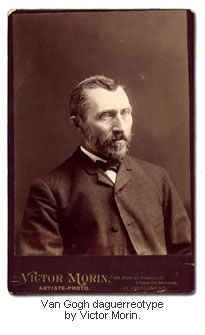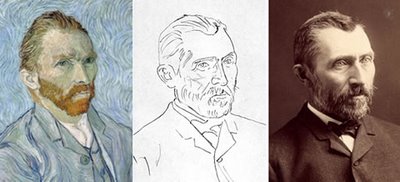
An air of mystery and fascination has surrounded Vincent Van Gogh ever since his death. Until today, the only photographs that existed of Van Gogh were from his teenage years....In Brussels around 1886, photographer Victor Morin took a number of photographs of local clergymen. Among these photos was a portrait of a man who bears an uncanny resemblance to the figure in many of Van Gogh’s self-portraits, leading some to speculate that this photo might be of the artist himself. Before the time of this photograph, Vincent’s self portraits were obviously “eyeballed” (to commandeer David Hockney’s phrase) and did not have a strong sense of realism. However, subsequent self-portraits were as close to photo-realism as impressionist paintings could be. Is it possible that Van Gogh used Morin’s photograph as a guide to painting these new, realistic self-portraits? Some experts now believe that the artist may, in fact, have used the photo along with optical projection as a guide when creating these paintings. This possibility is underscored by the fact that when the Morin photograph and some of Van Gogh’s self portraits are overlaid, the close resemblance is hard to deny. If this newly found photograph does indeed turn out to be of the adult Van Gogh, and if it could be proven that optical projection was used by this great impressionist, the implications could change art history. If Van Gogh used optics to trace his image from the photograph, how could he have done it? Techniques for optically transferring an image include using glass (a primitive lens), a concave mirror (another primitive lens), or a camera obscura or camera lucida. Van Gogh could have used any of these to project his photo onto canvas for tracing. Roger Vaughan, of The Camera Lucida Company in Great Britain, sent us a camera lucida to try some experiments for ourselves. We took the camera lucida and used it to make the sketch from the Van Gogh photograph.
If Van Gogh used optics to trace his image from the photograph, how could he have done it? Techniques for optically transferring an image include using glass (a primitive lens), a concave mirror (another primitive lens), or a camera obscura or camera lucida. Van Gogh could have used any of these to project his photo onto canvas for tracing. Roger Vaughan, of The Camera Lucida Company in Great Britain, sent us a camera lucida to try some experiments for ourselves. We took the camera lucida and used it to make the sketch from the Van Gogh photograph.
Camera lucida tracing of the Van Gogh photograph laid over the Saint-Rémy self-portrait with 50% opacity. The tracing is directly taken from the photograph except that the right eye was adjusted so that it’s looking at the viewer as in Van Gogh’s many self-portraits.
Continue reading at the always excellent Neatorama.
The article, written by Anthony Sapienza, originally appeared in full-length format in the premiere issue of Seventh Hour Blues, a music & arts magazine.
1 comment:
Finally our 15 minutes of warholesque fame arrived :)
Merci beaucoup
appreciated :)
Best
pK
Post a Comment